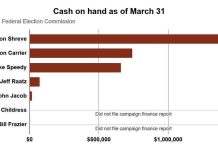
Pictured: A tassel with the year 2021 on it hangs from a cap during the commencement ceremony for Columbus North’s Class of 2021 on May 29 at the school. Mike Wolanin | The Republic
Bartholomew Consolidated School Corp.’s 2021 graduation rate — 84.86%, according to data released by the state — is slightly lower than that of 2020 or 2019.
However, given that the state had gotten rid of “hold harmless” rules it implemented during the previous year, Director of Secondary Education Bill Jensen was happy with the number.
“I am pleasantly amazed that we did not see a big drop,” he said.
According to the Indiana Department of Education, the 2021 graduation rates for local public schools are as follows, according to state standards:
Columbus North High School — 84.09% (428 out of 459), down from 87.90% in 2020 and 86.42% in 2019.
Columbus East High School — 85.86% (334 out of 389), up from 85.01% in 2020 and down from 86.37% in 2019.
BCSC overall — 84.86% (762 out of 898), down from 86.71% in 2020 and 86.40% in 2019.
Hauser Jr./Sr. High School — 93.42% (71 out of 76), up from 91.23% (52 out of 57) in 2020 and 86.30% (63 out of 73) in 2019.
The 2021 graduation rate for the state of Indiana was 86.69%. The 2020 rate was 87.69%.
However, state officials advised that “caution should be exercised” when comparing 2019 and 2021 rates to 2020. This is because the 2020 rates reflect a waiver on the Graduation Qualifying Exam for that year’s cohort, as the test could not be administered amid the pandemic. The state’s graduation rate for 2019 was 87.29%.
Jensen acknowledged that it is possible that a larger drop in rates could come in the future, as seniors weren’t the only grade affected by the impact of the pandemic.
“We don’t know what it’s going to look like down the road,” he said. “But right now, I have to say, I am really surprised that the 2021 data is as close to last year as it is.”
He also commended the work of iGrad coaches and the McDowell Education Center in helping students.
David Wintin, executive director of accelerated learning at Flat Rock-Hawcreek and former Hauser principal, said that it’s good to get a rate of more than 90%, though it’s always disappointing to have students who don’t graduate.
“We always have a pretty good idea of who’s going to make it and who’s not, but we pulled some kids through,” he said. “… With the number of obstacles in the last two school years — like I said, we’re disappointed when we don’t get everybody through, but we’re pleased we got as many through as we did.”
However, he also expressed concern about what the spring might hold, given continued issues caused by the pandemic. In discussing the outlook for 2022, he mentioned that about five or six students in an alternative school program (half online, half in-person) had already completed their graduation requirements at the end of the first semester. However, there are students who are “struggling to get through.”
In looking at specific student groups, BCSC was pleased by the graduation rates of Black, Hispanic and English Language Learners (ELL), Jensen said.
The groups’ rates were as follows:
Black — 86.36% (19 out of 22) in 2021, 81.82% (18 out of 22) in 2020 and 86.67% (26 out of 30) in 2019.
Hispanic — 82.79% (101 out of 122) in 2021, 78.05% in 2020 (96 out of 123) and 80.24% (94 out of 117) in 2019.
ELL — 85.42% (41 out of 48), 94.87% (37 out of 39) in 2020 and 73.53% (25 out of 34) in 2019.
Graduation rates for students who qualified for free and reduced meals dropped noticeably from 2019 to 2021. The group had a 75.31% (180 out of 239) graduation rate in 2021, down from 84.02% (184 out of 219) in 2020 and 81.78% (220 out of 269) in 2019.
In contrast, students with paid meals had a 94.01% graduation rate in 2021, 95.77% in 2020 and 95.10% in 2019. Jensen noted that the disparity between these two groups was probably the widest gap of all.
“Our economically disadvantaged students struggled the most,” he said. “And that doesn’t surprise us at all. … It’s so important to get those students in school, in class, so again, they have equitable resources and equitable instruction that they may not be able to get at home.”
During the 2020-21 school year, all grades moved to eLearning in November. The second semester then began with in-person learning for elementary schools and a hybrid model for secondary students, who later returned to in-person in phases.
The department of education reported that 2021 graduation rates correspond with research showing “substantial” academic impacts from the pandemic.
“According to research from IDOE and the National Center for the Improvement of Educational Assessment, Inc., the academic impact ranges from moderate to significant across schools, academic subjects and demographic groups,” state officials said. “In response, IDOE launched several accelerated learning programs, which are still underway and will be joined by additional efforts planned for next year.”
Jensen said it’s difficult to make a prediction about what 2022 will hold for graduation rates.
“Hopefully we’ll be pleasantly surprised again, but it’s just so hard to understand and look at what’s happening with our students, what they’re going through,” he said. “But I think if we can keep them and have a more normal learning environment for them, then we hopefully will be able to maintain at least what we were happy that we saw this year. We don’t have a crystal ball.”




